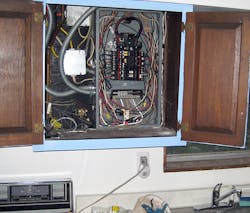Code Clusters is a fond look back at some of the most interesting and outlandish Code violations published in the pages of EC&M magazine over the past 15 years — the item below is the eighth in a series of 10. Questions? Comments? We’d love to hear your feedback! Post your thoughts in the box below.
What's for Dinner?
All references are based on the 2008 edition of the NEC.
This beautiful installation was sent to us by John Anderson, a longtime reader of EC&M.
The most obvious violation with this installation is the lack of “Work Space,” as defined by 110.26. Part (A)(1) defines the “depth” of work space. While the minimum “depth” required by Table 110.26(A)(1) of 3 ft is satisfied with the cabinet doors open, it could be argued that closing the cabinet doors essentially constitutes a violation of the rule in the first paragraph of 110.26, which states, “Sufficient access and working space shall be provided and maintained about all electrical equipment to permit ready and safe operation and maintenance of such equipment.” And while it appears that the minimum 30 in., or the equipment width, as specified in 110.26(A)(2), has been provided, it seems as if a person would be put in a compromised position while working on this panel, because reaching inside the cabinet would limit the “elbow room” this rule is intended to ensure.
The one undeniable violation here is the failure to comply with 110.26(A)(3). This section says, “The work space shall be clear and extend from the grade, floor, or platform to the height required by 110.26(E). Within the height requirements of this section, other equipment that is associated with the electrical installation and is located above or below the electrical equipment shall be permitted to extend not more than 6 in. beyond the front of the electrical equipment.”
Obviously, the cabinet in which the panel is located is not part of the “electrical installation.” Therefore, the cabinet is intruding on the required work space “height.” The countertop is also in the work space. Furthermore, the electric range, which technically is part of the “electrical installation,” is not the kind of equipment that is addressed by the wording of 110.26(A)(3). Even if it was, it clearly extends beyond the 6-in. maximum stipulated by this rule.
Another concern is the white-colored conductor terminated under a circuit breaker terminal. It is not completely clear exactly what the white conductor is being used for, but whether this is a phase or neutral conductor, such use is either a violation of 200.6(A) or 240.22. The first sentence in 200.6(A) states, “An insulated grounded conductor of 6 AWG or smaller shall be identified by a continuous white or gray outer finish or by three continuous white stripes on other than green insulation along its entire length.” If the conductor in question is a phase conductor, then it may not be colored white, which is reserved for grounded conductors only.
If the conductor in question is, in fact, a grounded conductor, then this application violates the rule of 240.22, which says, “No overcurrent device shall be connected in series with any conductor that is intentionally grounded, unless one of the following two conditions is met: (1) The overcurrent device opens all conductors of the circuit, including the grounded conductor, and is designed so that no one pole can operate independently,” or “(2) Where required by 430.36 and 430.37 for motor overload protection.” Neither one of those conditions exists here; therefore, if this is a grounded (neutral) conductor, it’s a violation of 240.22.

